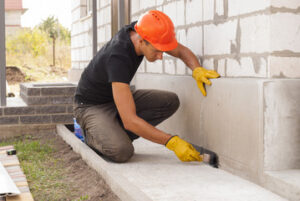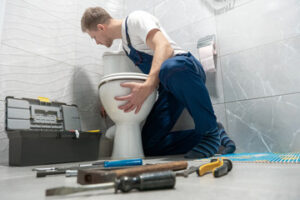If your foundation is sagging, it can cause problems throughout your house. During a foundation repair, supports are installed beneath the home to return it to its original elevation. This will close cracks, re-align doors, and help the entire home function properly.

Learn more about the different repair methods, costs, and warning signs. Recognizing these early signals will help prevent future damage and costly repairs. For professional help, contact Plano Foundation Repair.
Foundation damage can be costly to repair and may threaten the structural integrity of a home or building. Recognizing the signs of foundation problems and taking action to ensure repairs are made in a timely manner can help protect the value of a property and the safety of its occupants.
Cracks in walls, floors, and ceilings are the most common sign of foundation settlement. These cracks can vary in size and direction and are a result of varying stresses on the foundation. For example, vertical cracks typically indicate normal settling while horizontal cracks may be caused by soil movement or hydrostatic pressure.
Another telltale sign of a shifting foundation is gaps around doors and windows. As the foundation shifts, the frame of a house or building can distort and cause doors and windows to no longer fit properly or latch correctly. Gaps around these openings can also allow water and pests to enter the structure, which can lead to further damage and increased costs for repairs.
Uneven floors are another indicator of foundation problems. When areas of a floor feel lower than other parts of the same level, this is a sign of a shifting foundation that requires immediate attention to prevent further damage and protect the safety of occupants. In addition, sagging floors may be caused by soil erosion or inadequate drainage systems, and can create tripping hazards for visitors and increase the risk of mold and mildew growth.
Bowing and buckling walls are also serious signs of foundation problems. These buckling walls usually indicate significant pressure on the foundation walls from soil movement or hydrostatic pressure, and can compromise the structural integrity of the building. The installation of wall anchors or carbon fiber straps is often needed to stabilize these walls and prevent further movement.
Sagging and uneven floors, sticking doors and windows, and gaps in walls are all signs of foundation issues that need to be addressed as soon as possible. These problems are often exacerbated by moisture and require prompt attention to avoid more extensive damage, potential safety risks, and high repair costs.
Causes
The foundation of any building supports everything else – walls, floors, doors and windows. When it is damaged, the entire structure of the building is at risk and can cause major issues. If not addressed promptly and effectively, the damage can lead to unsafe living conditions.
Various causes can contribute to foundation damage. These include poor drainage, which can cause soil expansion and affect the stability of the foundation. Thermal expansion, changes in temperature that cause concrete to expand and contract can also impact the stability of the foundation. Poor construction practices and the use of inferior materials can also contribute to structural failures.
Signs of foundation damage can include cracks in walls, floors and around doors and windows. Stair-step cracks in brick walls and gaps in exterior brick are indicative of shifting or settlement of the foundation. Doors and windows that no longer open or close properly may also indicate a foundation problem. Uneven floors that slope or feel spongy are another indication of foundation problems.
Water leaks are a serious concern, as they can cause widespread damage to the foundation and the building itself. It is important to address water leaks immediately to prevent more severe damage and costly repairs in the future.
Severe and widespread damage to the foundation may require replacement to ensure the structural integrity of the building. This is especially true if there are cracks and displacement in key areas of the foundation, including the sill plates that support the beams of the building.
Regularly inspect the outside of your home for signs of foundation damage. Make sure that there are no leaks from gutters, downspouts or water-saturated soil. Make sure that there is adequate drainage and that the landscaping slopes away from the foundation. Keep an eye out for signs of tree roots that extend under the foundation. Ensure that the soil under and surrounding the foundation is well-compacted and free of debris. If you suspect a problem, contact an engineer for professional assessment and recommendations. Engineer-recommended solutions are designed to offer long-term stabilization and are tailored to the unique conditions of each foundation.
Repair Options
There are many different ways to repair your foundation. Some methods are more expensive than others, but they all have one thing in common: they can protect the long-term value of your home.
The type of damage your home is experiencing will determine the best solution. Cracks in walls and floors may suggest settling or sinking, while bowing walls can indicate a structural problem. Moisture intrusion and soil pressure are also common causes of foundation damage. If left untreated, these issues can exacerbate damage to your home’s structure and interior finishes.
Once a professional has assessed the damage, they can recommend a specific repair method. Choosing the right solution will help prevent further problems and keep your home safe for your family.
Most foundation repair methods involve removing dirt from the area around your home to provide a stable base. This can take a few days, but it will allow contractors to access areas of your home that might otherwise be inaccessible.
During the repair process, your contractor will patch cracks in your foundation walls. This will stop water from seeping into your basement or other rooms and causing further damage. It can also prevent moisture and soil from entering your home’s basement or crawl space, where it could cause further damage.
If your home’s concrete slab has shifted or sunken, a technique called “slabjacking” can be used to raise the slab back to its original position. This repair method is quicker and less disruptive than other repairs, such as complete slab replacement.
Another repair option is underpinning, which involves installing steel pilings below your foundation to support it from underneath. This is a more invasive repair, but it’s also the most effective in terms of stabilizing your foundation and preventing further damage.
When the time comes to choose a repair method, be sure to consider the benefits of each and weigh your options carefully. Remember, the longer you wait to address your foundation problems, the more costly and extensive the repairs will be. While foundation problems can be scary, knowledge is your greatest ally in this fight!
Cost
The cost of foundation repair can vary widely depending on the scope of work required and the cause of the damage. Understanding some of the factors that influence price helps homeowners anticipate expenses and plan accordingly. These include the size of the home, soil conditions, labor and materials costs, and geographical location. In addition, inspection fees and permit charges might be required to meet local building standards, adding to the overall cost of the project.
Regardless of the extent of damage, prompt repairs can save homeowners from costly structural issues down the road. Uneven floors, sticking doors, or damp basements might seem like minor annoyances at first but can lead to significant problems such as mold growth and musty odors if left unattended. Choosing a reputable contractor, ensuring that proper drainage systems are in place, and regularly performing maintenance can help mitigate these risks.
There are a number of different repair options, including slabjacking, underpinning, and bell-bottom piers. Each method has its own benefits and considerations, but they all aim to restore a home to its original elevation. This prevents further damage, closes cracks, and re-aligns doors and windows, so they work as they were originally intended to do.
Another factor that impacts the cost of foundation repairs is the quality of materials used. While utilizing the lowest-cost materials might save up front, they may not last as long or perform as well as high-quality products. As a result, it is often worth paying a little more for a longer-lasting solution that will reduce the need for future repairs.
The cost of foundation repair can add up quickly, but a little planning and preparation can help homeowners manage these expenses more effectively. By getting multiple quotes, scheduling repairs during off-peak times, and utilizing the right maintenance measures, homeowners can minimize their expenses without compromising on quality. The key is to take a proactive approach to your home’s foundation health and stay up-to-date on the latest repair methods and techniques. Doing so can keep your home safe and healthy for years to come.

